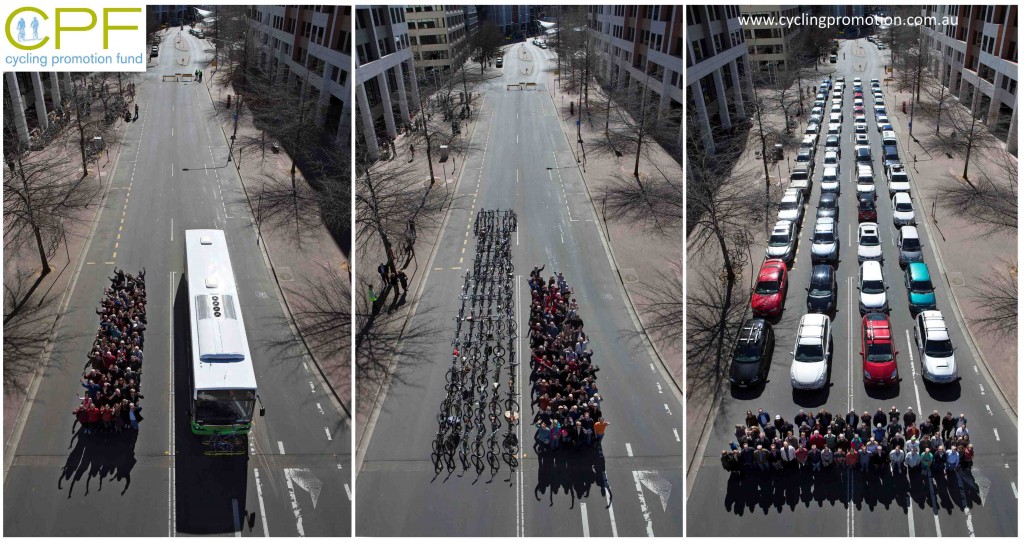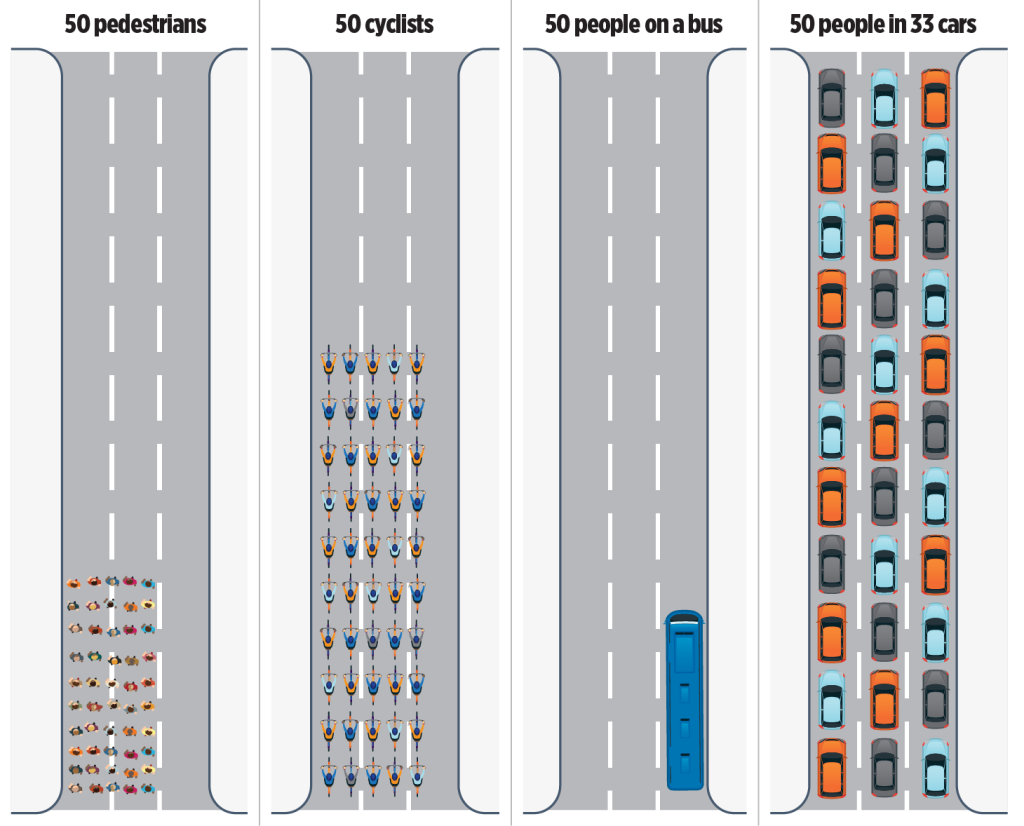American cities are notoriously spread out. Since the highway building boom of the 1950’s American cities have moved strongly away from public transit and walk-ability towards a more auto dependent infrastructure. We spend hundreds of billions of dollars every year on our roads and highways alone (1)(2). In rural areas, this road and highway infrastructure is vital for our agricultural and resource extraction industries. Unfortunately we have extended this model of the private automobile and the freedom of the rural road into the city where real estate is much more valuable. Public transportation is an order of magnitude more efficient in its use of real estate. To demonstrate this, I collected the following set of images. In all of them it is quite evident that the amount of infrastructure required to move a fixed amount of people is drastically reduced with public transportation.







The crazy thing is that we have created a world class network of road and highway infrastructure. Unfortunately, we have been abusing this infrastructure by using it predominantly for private automobile usage. In rural areas this is not a problem because there aren’t a ton of people using the roads. But in our cities we have consistently bumped into and past the capacity factor limits for private automobile usage on our highways and roads. Please see my previous article on transportation capacity factor comparisons between trains, buses, and cars. www.greensail.net/2019/02/vehicleflow-versus-trainflow/ We now find ourselves in cities that are designed for the automobile at the expense of these other forms of transportation. This automobile focus has twisted not only our infrastructure investments but also our development patterns to the extent that massive amounts of our city real estate is dedicated to automobile travel, automobile parking, and automobile sales, distribution, and maintenance service facilities. Unfortunately this has come at the expense of our communities and our quality of life, and in particular our financial freedom. Citizens find themselves trapped in a cycle of automobile dependence, tens of thousands of excess deaths every year, debt, urban sprawl, pollution, negative health impacts, and environmental and habitat destruction. Worst of all, it makes it even more difficult to transition to better public transit as the distances between different structures are pushed farther and farther apart by larger and larger parking lots.

Furthermore, from an equity standpoint, over the years, these development patterns have made it increasingly difficult to live and work without access to an automobiles. Getting from point A to point B with public transit has become something increasingly and predominantly reserved for those with no other options. The discrepancy between the convenience for those with automobiles and those without that rely on public transportation has risen to the point where it often takes at least twice as long to use public transit instead of an automobile and, while still cheaper the automobile ownership, is often quite expensive for the service you get.

But there is hope!
Here’s the thing, in our cities, public transportation is more efficient, more cost effective, and has the potential for higher capacity than private automobiles. An effective public transportation system is the only way for us to solve automobile traffic congestion. We need a public transit system that can get people from point A to point B in roughly the same amount of time or just a few minutes longer than it would take with an automobile. In order to achieve this, we must look at the fundamental physical, social, and economic limitations within which our systems are operating, the resources we currently have, and figure out how best to deploy those resources to create excellent and competitive public transportation systems.

Context is important
Before I get into solutions, I would like to address the specific context within which I am proposing to improve public transit systems. It is not really meant for wonderful pedestrian streets in dense urban areas like the photo shown above from Barcelona. At the end of the day, this is something I believe less dense cities should aspire to at least in their urban cores and around transit stations. But, that is not what exists right now. The solutions proposed are for large spread out metro areas with populations between 500 thousand and 5 million people. These are cities that are automobile centric in that they are built around highways. This infrastructure development is reflected also by the reality that automobile trips always comprise more than 70% of daily trips in these cities. Furthermore, these are typically cities where over half of the housing stock is single family homes and parking lots dominate the landscape of commercial areas (ie mostly not dense). Perhaps more crucially, these are cities where there is a functioning high density downtown core of offices, retail, other commercial activities, and sometimes housing, but most people commute to this central core on a daily basis from suburbs in the periphery. At the moment, these cities usually only experience bad traffic during peak rush hour times and the rest of the day it is fairly easy and smooth to drive anywhere in the city. During my University studies, I looked specifically at the metro area of Des Moines Iowa and the Des Moines Area Rapid Transit system or DART. Please see my portfolio piece on this project. https://www.greensail.net/2023/03/how-to-make-the-desmoines-area-rapid-transit-system-amazing/

Assumptions
To begin my study, I assumed that we would want to have automobiles only comprise 20% of daily trips, and all other forms of transit comprise the other 80%. This is basically the inverse of the current status quo for most of these cities. However, we would need to start with the reality that only 10% of people will use whatever system we propose for at least the first year and that it will take significant amounts of time for people to see the new system and switch their habits.

Observations from my studies
- The capacity factor of heavy rail trains is overkill for the daily volume of commuters
- Light rail capacity factors are also fairly high for the expected daily volume of commuters
- Buses appear to be the most cost effective and appropriate solution for the desired daily volume of commuters in these types of cities.
- Driver time is the single biggest operational cost of the agency.
- Non-service (basically non-revenue generating overhead) is a large percentage of driver time to get to and from bus depots.
- Service intervals are one of the biggest factors for usage and long intervals between buses kill transit network effects.
- Bus speeds are slower than the city traffic average of 19mph.
- It is uncomfortable to wait at an exposed bus stop where automobiles might spray water or snow onto passengers during inclement weather days, the sun might burn your skin, or the heat or cold makes it very undesirable for someone going into a professional work environment.
- Service capacity for buses is more limited by driver availability than it is by bus availability.

So how do we create world class transit in our auto dominated cities?
- Create a three tiered bus network that leverages existing infrastructure for automobiles.
- Tier 1 – Fast loading highway buses
- Enclosed and conditioned pre-boarding stations
- Buses level with platform and having a high ratio of doors to seats to enable quick and efficient loading and unloading of passengers including those in wheelchairs.
- Operating speeds at 55mph to 70mph
- 5 minute peak service intervals
- 24/7 service.
- Stations are spaced at least 1 mile apart.
- Every station connects directly with a Tier 2 bus station.
- These buses don’t get off the highway so that they can move people very quickly over large distances. Staying on the highway, operating at highway speeds, and pre-boarding passengers are all critical. These features enable just a handful of buses to provide a very high level of service by drastically reducing their route cycle time. Using a highway route that loops around on it self and is located adjacent to a bus depot can almost completely eliminate non-revenue mileage for these buses, making these routes extremely fast, efficient, and resilient to disruption.
- Tier 2 – Large avenue standard buses
- Enclosed and conditioned pre-boarding stations
- Standard city bus with station platform level design to be flush with bus to enable quick and efficient loading and unloading for all passengers including those in wheelchairs.
- Typically run at 25mph to 45mph
- 10 minute peak service intervals
- Stations are located about every half mile, mainly at major avenue intersections so passengers can quickly connect to other routes.
- 5am to 2am service.
- It is crucial that these buses should have a dedicated bus lane so they do not get stuck in traffic. The dedicated lane combined with pre-boarding passengers at stations enables the same amount of buses to provide much faster service and moderately reduces route cycle time.
- Tier 3 – Neighborhood vans and small buses
- Sign post bus stops.
- These buses would typically run at 15mph to 20mph with
- 15 minute peak service intervals
- These buses start at, end at, and connect with the closest Tier 2 or Tier 1 stations.
- Frequent stops every block or as needed by the local neighborhood.
- Service times could vary by neighborhood needs.
- Since these buses only operate locally, the shorter distance of the route reduces the route cycle time and isolates the potential for loading or driver delays to accumulate and begin impacting connection reliability of the overall system.
- Tier 1 – Fast loading highway buses
- Provide 24/7 service connections to common visitor entry points like airports, seaports, bus depots, and train stations with the highway buses where possible. The goal is to make it easy, convenient, and guaranteed for people to travel to these locations when they want to travel into or out of the city. Where a highway bus is not feasible, use a large avenue bus with a 24/7 operational schedule to make the connection. When local residents travel outside of the city from one of these ports, they have to know that they can get back home or close to home no matter what time they might return.
- Connect with and create spaces for bicycles inside transit vehicles and at transit stations to encourage multi-modal transport.
- Where possible create bus routes with bi-directional loops so that buses can be introduced and removed at the bus depot nearest the loop. This helps to minimize non-revenue mileage while also minimizing any potential passenger route interruption.
- Profit.

References
- https://www.census.gov/library/stories/2019/12/2020-census-count-guides-funding-of-new-roads-and-bridges.html
- https://www.urban.org/policy-centers/cross-center-initiatives/state-and-local-finance-initiative/state-and-local-backgrounders/highway-and-road-expenditures
- https://www.bts.gov/statistical-products/surveys/national-household-travel-survey-daily-travel-quick-facts
